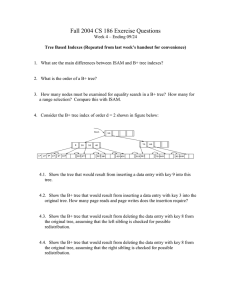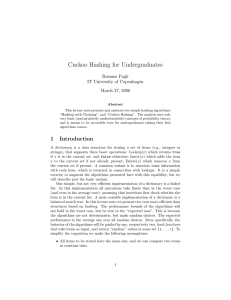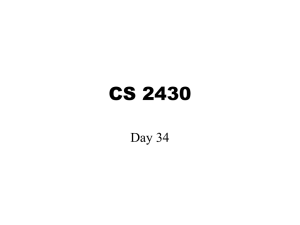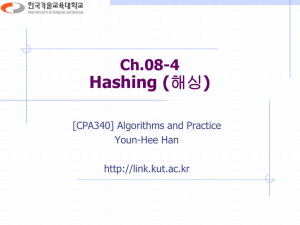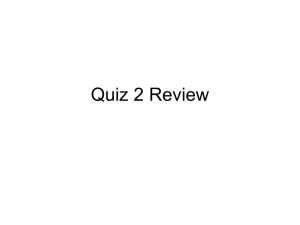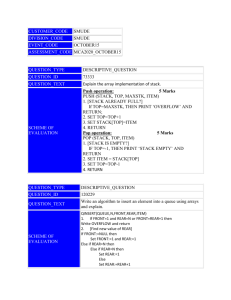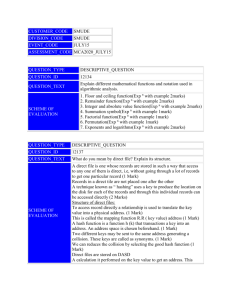Week 04-Solutions
advertisement
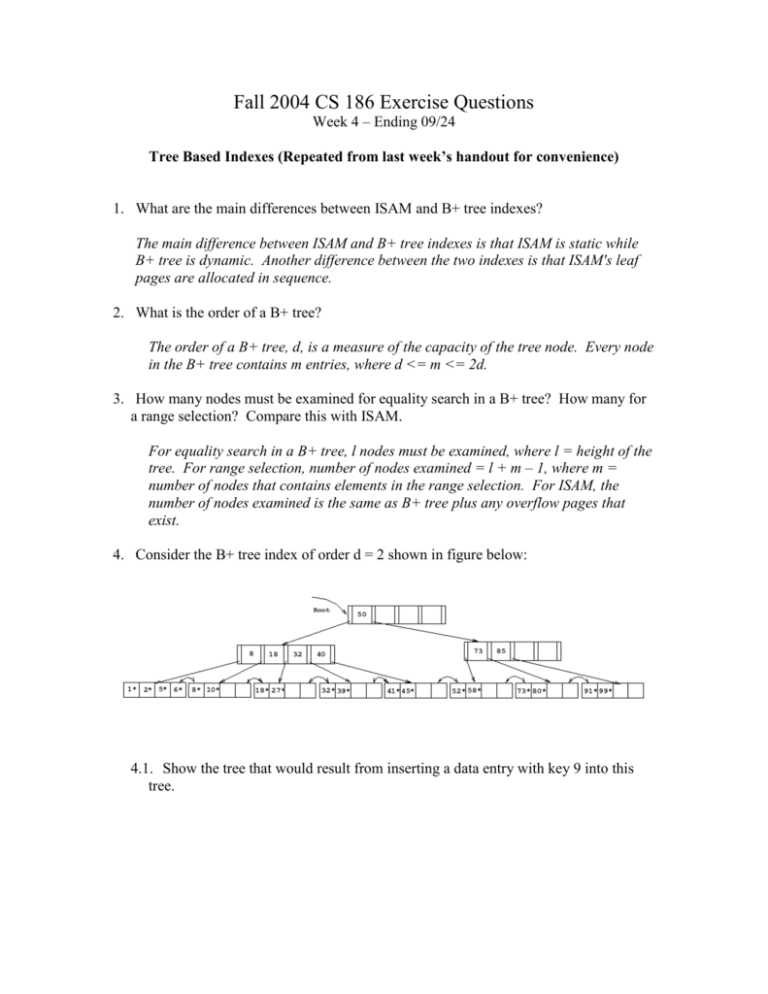
Fall 2004 CS 186 Exercise Questions Week 4 – Ending 09/24 Tree Based Indexes (Repeated from last week’s handout for convenience) 1. What are the main differences between ISAM and B+ tree indexes? The main difference between ISAM and B+ tree indexes is that ISAM is static while B+ tree is dynamic. Another difference between the two indexes is that ISAM's leaf pages are allocated in sequence. 2. What is the order of a B+ tree? The order of a B+ tree, d, is a measure of the capacity of the tree node. Every node in the B+ tree contains m entries, where d <= m <= 2d. 3. How many nodes must be examined for equality search in a B+ tree? How many for a range selection? Compare this with ISAM. For equality search in a B+ tree, l nodes must be examined, where l = height of the tree. For range selection, number of nodes examined = l + m – 1, where m = number of nodes that contains elements in the range selection. For ISAM, the number of nodes examined is the same as B+ tree plus any overflow pages that exist. 4. Consider the B+ tree index of order d = 2 shown in figure below: 4.1. Show the tree that would result from inserting a data entry with key 9 into this tree. 4.2. Show the B+ tree that would result from inserting a data entry with key 3 into the original tree. How many page reads and page writes does the insertion require? The insertion will require 5 page writes, 3 page reads and allocation of 2 new pages if the new page on the leaf level is the left-most node (containing 1,2, and 3). If the new page on the leaf level is the second to left-most node, the insertion will require 6 page writes, 4 page reads and allocation of 2 new pages. Obviously, the former insertion is preferred because it requires fewer I/Os. 4.3. Show the B+ tree that would result from deleting the data entry with key 8 from the original tree, assuming that the left sibling is checked for possible redistribution. 4.4. Show the B+ tree that would result from deleting the data entry with key 8 from the original tree, assuming that the right sibling is checked for possible redistribution. 4.5. Show the B+ tree that would result from starting with the original tree, inserting a data entry with key 46 and then deleting the data entry with key 52, assuming that the right sibling is checked for possible redistribution. 4.6. Show the B+ tree that would result from deleting the data entry with key 91 from the original tree. Hash Based Indexes 1. Define static, extensible, and linear hashing, and describe the advantages and disadvantages of each. Static Hashing is a hashing technique where the buckets that hold data entries are statically allocated. If too many records are inserted for a given bucket, the system creates overflow pages. While this technique is simple, it can require many I/Os to find a specific data record if that record is in a bucket with many other records. Extensible Hashing is a hashing technique that does not require overflow pages. Extensible Hashing uses a directory of pointers to buckets. When a page for a bucket overflows, the bucket is split. This splitting occasionally requires the doubling of the directory structure. As stated above, this technique does not require overflow pages. However, it requires the space overhead of the directory, and possibly (but not likely) an extra I/O for the directory lookup. Linear Hashing is a dynamic hashing technique that handles the problem of long overflow chains without a directory. Linear Hashing uses temporary overflow pages, and chooses the buckets to split in a round-robin fashion. Linear Hashing requires no dynamic directory structure, only a counter for “next” and “level”. However, it does have some overflow pages, and it may require more than 1-2 I/Os for a lookup. 2. In Extensible Hashing, why do you use the least significant bits of the hash value to determine the directory slot of a data item? If the least significant bits are used, the system can copy the old directory, and use this new copy as the second half of the new directory. After the copy, only one of the directory pointers for the bucket that split needs to be updated. 3. Consider the following hash index built using extensible hashing. The global depth is above the directory, and a local depth is attached to each bucket page. <number>* represents a data entry with the hash value <number>. Each bucket can hold at most 3 data entries. Show the hash index after the insertion of data entry 24*. Given this insertion, then show the index after the insertion of 13*. 2 8* 20* 16* 2 00 01 10 11 2 1* 9* 5* 2 2* 6* 2 3* Answer: After insert of entry 24* 3 8* 16* 24* 3 000 001 010 011 2 1* 9* 5* 2 2* 6* 100 101 110 111 2 3* 3 20* After insert of entry 13* 3 8* 16* 24* 3 000 001 010 011 100 101 110 111 3 1* 9* 2 2* 6* 2 3* 3 20* 3 5* 13* 4. Consider the following hash index built using linear hashing. The arrow to the left of the pages indicates the “next” pointer. <number>* represents a data entry with the hash value <number>. Each page can hold at most 3 data entries. Assume each row of pages refer to the same bucket, and that the buckets are arranged in increasing hash value from top to bottom. Show the hash index after the insertion of data entry 13*. Given this insertion, then show the index after the insertion of 24* and 48*. N=4 level = 0 next = 0 8* 20* 16* 1* 9* 5* 2* 6* 3* Answer: after insertng 13*: (NOTE: hash function info. in grey shown for illustration only) j N=4 level = 0 next = 1 H0 00 H1 000 8* 16* 01 001 1* 9* 5* 10 010 2* 6* 11 011 3* 00 100 20* 13* After inserting 24* and 48*: (NOTE: hash function info. In grey shown for illustration only) N=4 level = 0 next = 2 H0 00 H1 000 8* 16* 24* 01 001 1* 9* 10 010 2* 6* 11 011 3* 00 100 20* 01 101 5* 13* 48*
